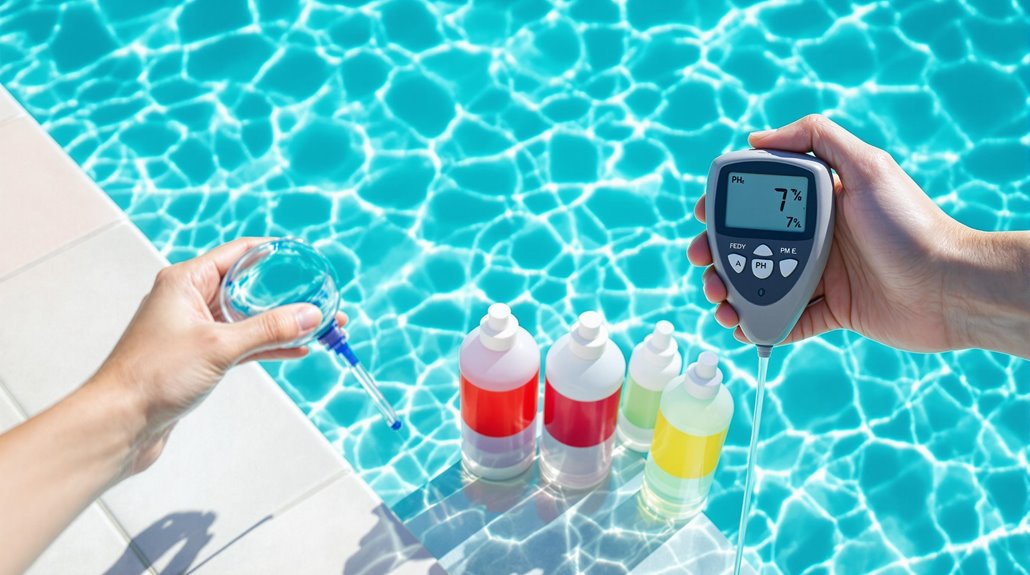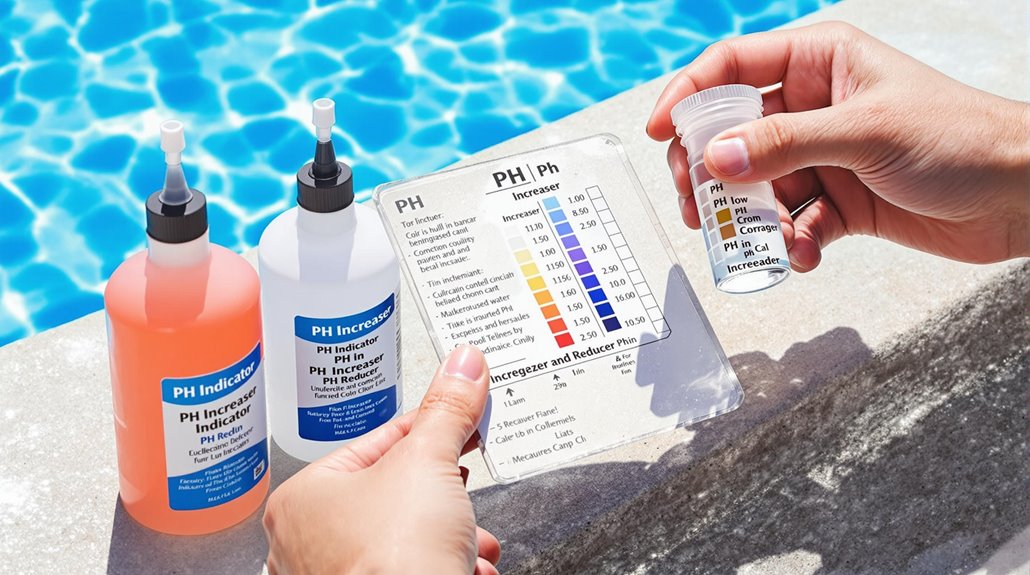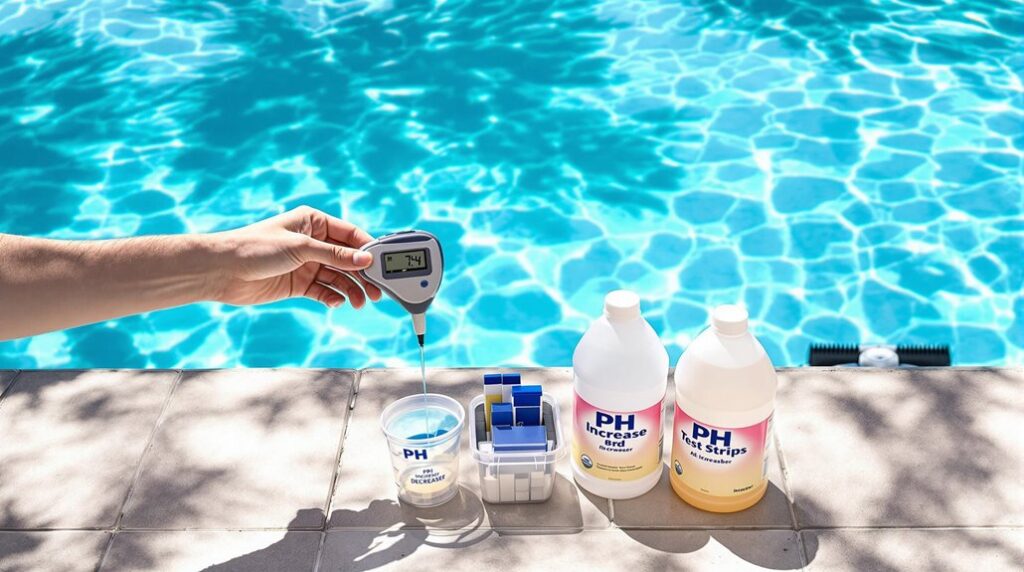To maintain proper pool pH levels between 7.2 and 7.8, you’ll need basic testing equipment such as pH strips or digital meters, plus chemicals for adjustments. At the point levels are high, add muriatic acid or sodium bisulfate through return jets; for low pH, distribute soda ash or baking soda around the pool. Always run your filter for 20 minutes after adding chemicals and retest to confirm. Understanding additional maintenance techniques will assist you in perfecting your pool’s chemistry.
Understanding Pool Ph and Why It Matters

While maintaining your pool might seem complex, understanding pH levels is the foundation of proper pool care. Your pool’s pH needs to stay between 7.2 and 7.8 to keep swimmers safe and your equipment protected. Think of pH as your pool’s comfort zone – it measures how acidic or alkaline your water is on a scale from 0 to 14. When chemical tests indicate issues, failed pH readings often require immediate troubleshooting to prevent further problems. Regular year-round maintenance ensures consistent pH control and safer swimming conditions.
You’ll want to keep your pool’s pH close to your body’s natural level, which is around 7.0-7.4. Whenever pH strays from the ideal range, you’ll face issues such as eye irritation, equipment damage, and reduced chlorine effectiveness. Your pool’s pH constantly changes due to factors such as rain, swimmer activity, and debris. That’s why regular testing is essential – it helps you catch problems before they affect your swimming experience or damage your investment. If your pool appears cloudy, it could indicate that your pH balance is off, requiring immediate attention and adjustment.
Essential Tools and Chemicals for Ph Control
Managing your pool’s pH necessitates the right set of tools and chemicals for accurate testing and adjustments. You’ll need reliable testing equipment such as pH strips ($5-$10) or digital meters for precise readings, plus essential safety gear including thermal gloves and eye protection while handling chemicals.
For lowering pH, you’ve got alternatives: traditional muriatic acid through automated feeders, granular sodium bisulfate for reduced burn risk, or eco-friendly CO2 injection systems that eliminate chemical handling. To raise pH, you can use sodium bicarbonate or soda ash, although you’ll want to dissolve them properly to prevent clouding.
Smart controllers such as IntellipH® make the process easier with automated dosing and real-time monitoring, while integrated systems work seamlessly with your existing pool equipment for hassle-free maintenance.
Step-By-Step Ph Adjustment Methods

Every successful pH adjustment starts with a systematic approach that guarantees both safety and effectiveness. You’ll need to carefully test your water and identify any issues before making adjustments to achieve ideal results. Understanding your pool’s specific needs helps you take control of your water chemistry with confidence.
- Test your water’s pH and total alkalinity levels using digital meters or test strips, then calculate your pool’s volume for precise chemical dosing
- For low pH, broadcast soda ash or baking soda evenly around the pool’s perimeter while the pump runs
- To reduce high pH, add muriatic acid or sodium bisulfate through the return jets with proper safety gear
- Run your filter for at least 20 minutes after adding chemicals, then retest to confirm desired levels
Maintaining Perfect Ph Balance Year-Round
To achieve perfect pH balance throughout all seasons, you’ll need to establish a consistent testing and maintenance schedule that accounts for various environmental factors. Test your pool’s pH weekly, especially after heavy rainfall or during peak swimming periods, using reliable testing strips for accurate readings.
You’ll want to maintain pH levels between 7.2 and 7.8 while keeping alkalinity at 80-120 ppm to prevent unwanted fluctuations. Watch for factors that can disrupt your pool’s chemistry, including sun exposure, bather load, and weather changes. After adding any chemicals, recheck pH levels within a few hours to confirm they’ve stabilized. For saltwater pools, monitor salinity monthly, aiming for 2,700-3,400 ppm. Remember to prioritize testing after weather events, since airborne contaminants can greatly impact your pool’s pH balance.
Frequently Asked Questions
Can I Swim Immediately After Adding Ph-Adjusting Chemicals?
Wait 20-30 minutes after adding pH adjusters. Run pool pump for circulation. Test pH before swimming.
Why Does My Pool Ph Keep Dropping Even After Regular Adjustments?
pH drops occur from stabilized chlorine tablets, low alkalinity, or poor circulation. Address these core issues before adjusting pH.
How Do Extreme Weather Conditions Affect My Pool’s Ph Levels?
Hot weather lowers pH through evaporation and mineral buildup. Cold weather raises pH. Test and adjust pH more frequently during temperature extremes.
Should I Adjust Ph Differently for Saltwater Pools Versus Chlorine Pools?
Saltwater pools need frequent pH lowering due to alkaline drift. Chlorine pools need fewer pH adjustments as they trend acidic.
What Happens if I Accidentally Add Too Much Ph Increaser?
Adding too much pH increaser causes reduced chlorine effectiveness, scaling, skin irritation, and equipment damage. Add pH decreaser to correct.

